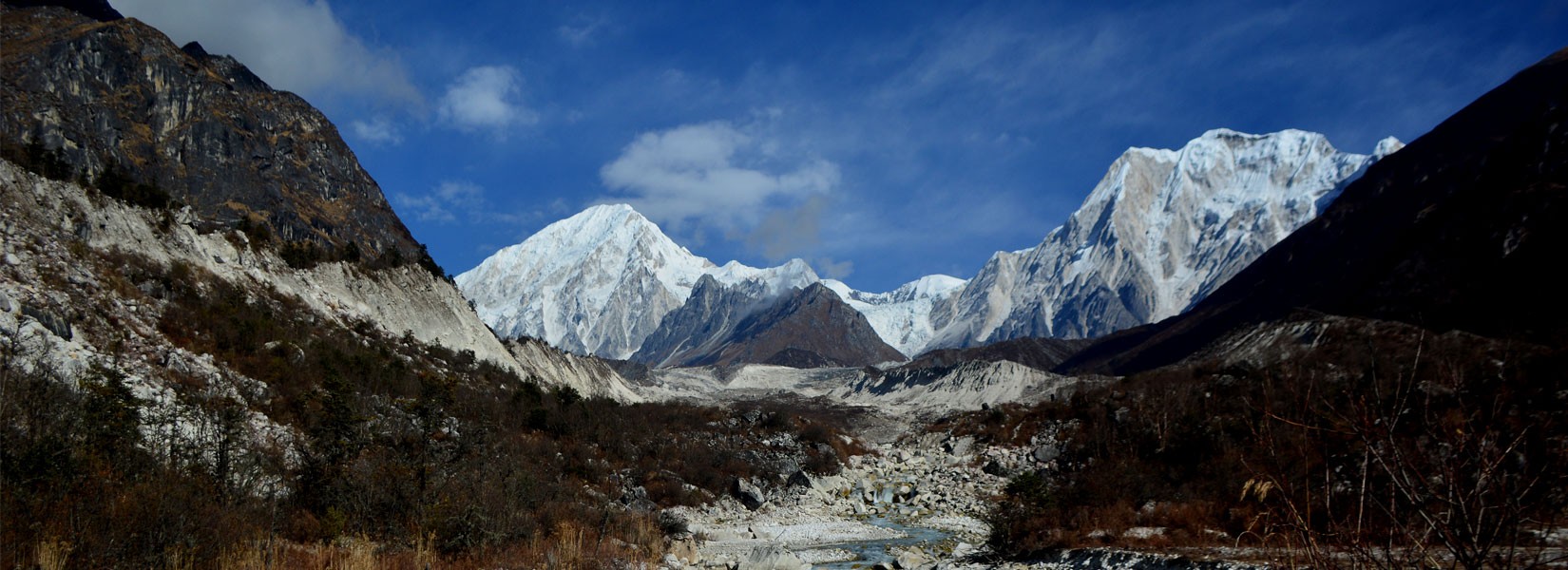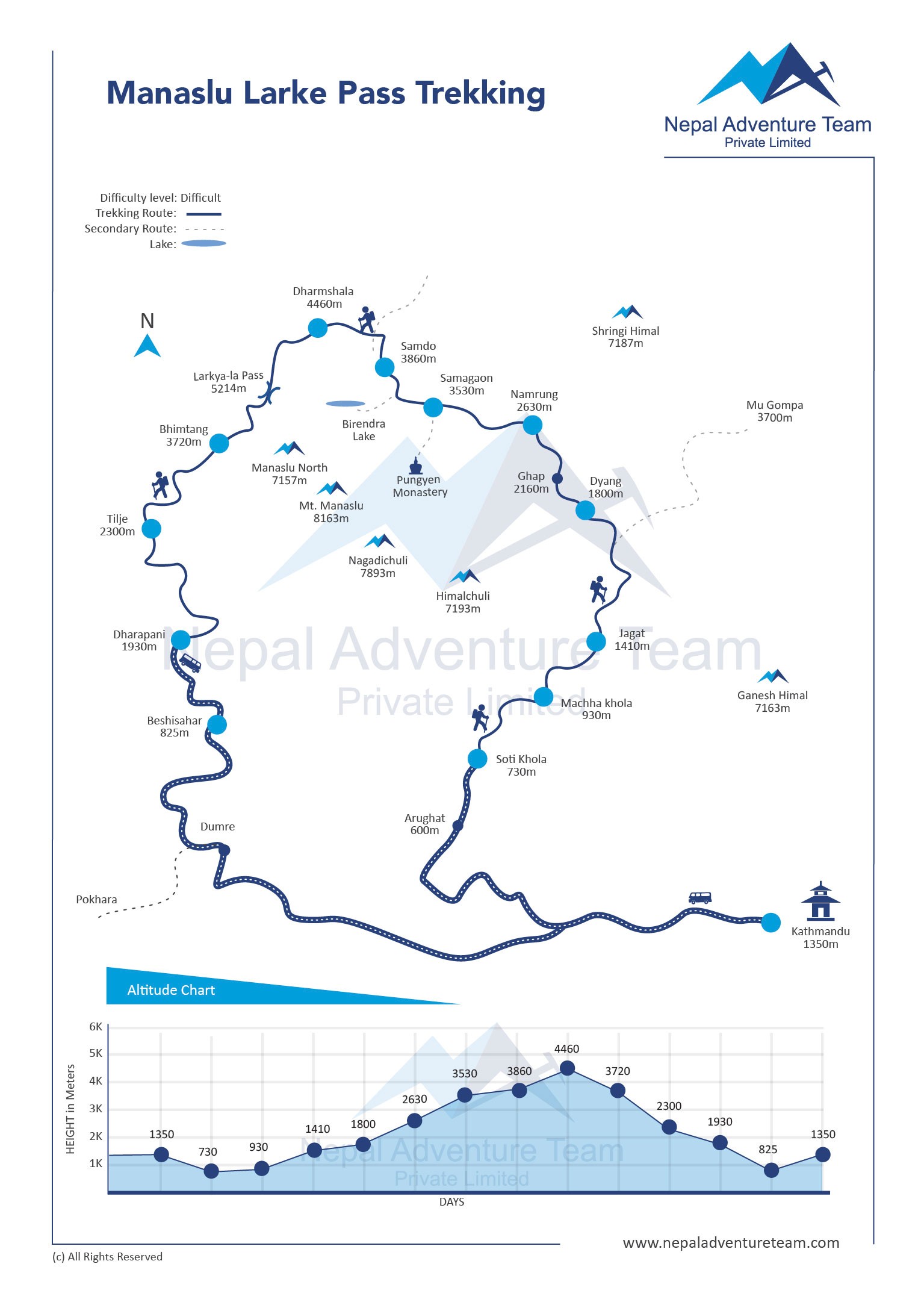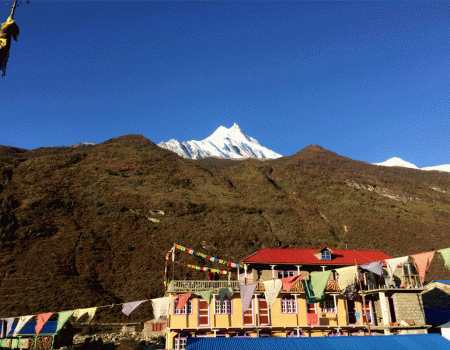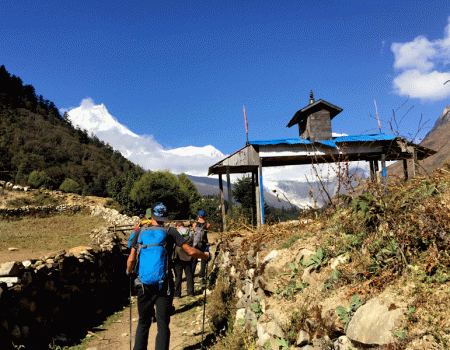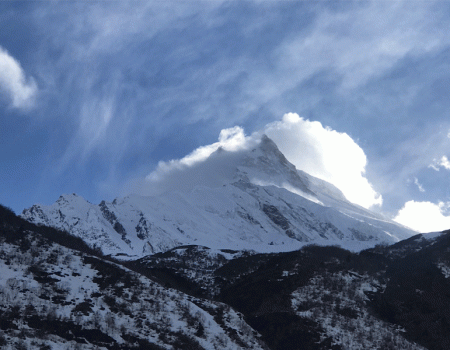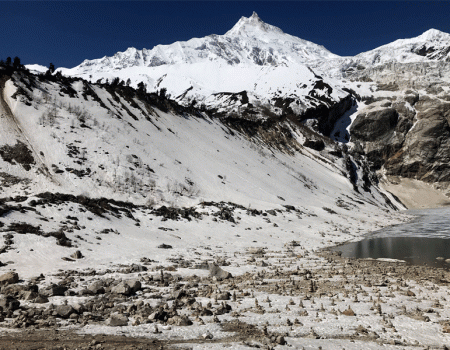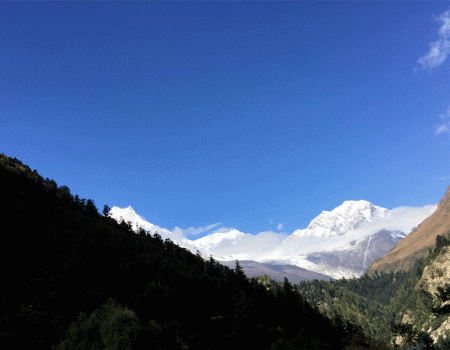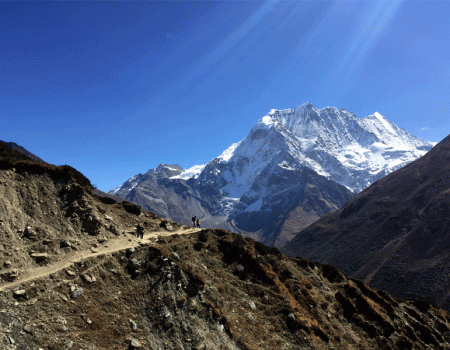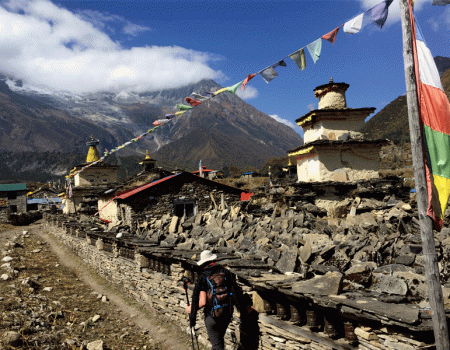The Manaslu Circuit trek is another challenging and popular trekking route in the Manaslu region. Trekking to Manaslu is one of the best and most amazing trekking trips as you will have an opportunity to explore Manaslu (8,163 m.) the eight highest peaks in the world, located in Nepal, and also have an opportunity to pass through the snow-capped peaks called Larke la to pass 5,106 meters (16,752 ft) from where you will have a range of mountains located in Manaslu and Annapurna trekking region.
Manaslu trek region area was opened in 1992 for outsiders basically to have trekking and some other sorts of tourism exercises. From that point forward, the trek to Manaslu, alongside the Larke Pass district, has been well known to have inconceivable scenes of one-of-a-kind scenes, regular miracles of snow-topped and rough slopes, and marvelous perspectives of the scope of mountains situated in the Manaslu locale. The term Manaslu implies the soul mountain, which stands to be a big-hearted and solid god in the neighborhood vernacular. The trek to the Manaslu circuit offers you a scope of great perspectives of the grand mountains. You will likewise be astounded by the mix of culture, novel ceremonies, and ways of life of assorted ethnic gatherings living along the trail that goes through the snow-topped pinnacles and icy masses; these are plain as day, which is why Manaslu locale trekking is the cherished and requested trekking. Correspondingly, you will likewise undertake the snow-topped pinnacles and ice sheets and go through rough slopes, these highlights sufficiently express how enterprise and prevalent trekking goal.
The challenging Manaslu circuit trek is the best decision for an adventurous journey trekking aficionados as it offers not simply a delightful view of nature and the mountains, however, it gives us an understanding of two distinct societies; Buddhism and Hinduism that bond together. Manaslu Circuit is an awesome trekking experience in the isolated Manaslu area of the Nubri valley of the Himalayas.
Manaslu Base Camp (4848m)
Manaslu base camp is the most exciting side trip of Manaslu circuit trekking, which will take you to the base of the world's eighth-highest mountain, Mt.. Manaslu. On the day of acclimatization at Sama Gaon, you can walk out of Sama village and walk through forests and the sharp climb takes you to Manaslu Base Camp at 4848m, marked by a lot of prayer flags to the top. You can face difficulty in breathing due to altitude. Thus, you need to maintain body hydration and walk slowly. You can get the best view of Mt. Manaslu and its vicinity from the base camp.
Manaslu Circuit Trek off Beaten Trails
The Manaslu round trek 2025/2026 is the most recommended trek for those seeking stunning locations and the essence of the Himalayas. Contrary to spectacular and known treks like the Everest or the Annapurna area, the Manaslu circuit has only a relatively small number of visitors and thus offers a great opportunity to discover Nepal's exotic and culturally fascinating sides. The trek is done along trekking trail passes, which offer wavy forests, streams and waterfalls, stark high-altitude trails, and valleys. The dominating notes are indeed those that reflect the silvery song of birds. And the countryside that you get to explore is mostly that of age-old villages, and the people are simple and courteous.
However, there is another significant point of interest regarding Trek to Manaslu: it is fairly off the beaten track. You might not find busy pathways such as the populated trails or those large tea houses popular with many visitors. Rather, there is a sequence of reinforced experiences that makes the feeling of being a part of the actual culture. A place for the traveller, the possibility to grasp the greatness of the Himalayas more deeply and strongly. Trekking is a great chance to become closer to people, learn something new about their lives, and turn the tide of their hospitality. You will be greeted with lovely, friendly smiles. The food and drink taste surprisingly plain and simple but incredibly delicious, and the overall atmosphere gives you a living and surviving feel that seems to sum up the essence of life in many of these regions.
The Manaslu Circuit Trek is an appealing portrayal of nature's adventurous charm by inviting tourists to Nepal. This trek is well concealed like a precious gemstone buried deep. When it unveils itself, what it reveals is awesomeness, complicated incline, and that indescribable essence of pursuing one's passion. It is perhaps one of the most challenging tasks that anyone can embark on. It also can fatigue the senses and make such deep and indelible impressions that can only be described as a haul. This is not only a physically straining trek; it is an incredible spiritual journey that affords a sufficient amount of time to become involved with the spirit of the Himalayas and to discover the beautiful creations of nature in Nepal.
Must-See Places Along the Manaslu Circuit Trek
The Manaslu Circuit Trek, located in the middle of the Nepal Himalayas, is an unforgettable chance to immerse in a stunning nature and culturally interesting and physically challenging experiences. Mount Manaslu, or Kunti Kesh, is also one of the most enchanting sights on this trek of 8,163m, the eighth tallest mountain in the world. The mesmerising view of this massive mountain, particularly for those who begin their trek from Lho or Samagaun, is something that would make human beings wonder at the creation of nature. These villages also make a splendid viewing platform and give a feel for the indigenous people whose way of life has been dominated by the Tibetan culture, with monasteries and stone houses typical of the culture dominating the area.
Another incredible site of the Manaslu Circuit is the thrilling Larkya La Pass, which substantially touches an altitude of 5,135 M. This high mountain pass is best known for its scenic topographical features, including Himlung Himal, Cheo Himal, and the Annapurna ranges. While the crossing of the pass offers wonderful sightseeing and is not technically difficult, it is the most rewarding experience on the trek because it is the highest point reached by the walkers, and many of them feel a sense of triumph alongside the beauty of the surroundings. It combines many facets of Katadin, such as the glacial terrains, snow-capped slopes, and steep valleys, which makes it an exciting trip.
This hike also offers stunning views of the beautiful village of Samdo, which lies at the border of Tibet. Samdo is the lodge of the last stop before the beginning of the Larkya La trek. This lodge offers a chance to experience the life of the people living at such an altitude. The village is native to descendants of Tibetan refugees in terms of its traditional living culture, monasteries, and yaks. The cultural journey of Samdo itself, along with hosts partnering with local people of the region, offers trekkers profound cultural saturation.
Finally, the Manaslu Circuit Trail, with stunning mountains and lakes, includes Birendra Lake, located near the village of Samagaun. The glacial lake of B Gone is surprisingly beautiful, and we spent the day here resting and enjoying the view of Manaslu and the mountains beyond. The peaceful setting of these areas contrasts the challenging terrains and difficult roads, which will be covered on the treks; thus, trekkers get to have some moments of rest to marvel at the beauty of their surroundings. These varied and intriguingly pictured sites along the Manaslu Circuit Trek form an engaging and breathtaking trek in one of Nepal's remote and stunning corners.
Best Time for Manaslu Circuit Trek
The Manaslu Circuit Trek, known as one of the most beautiful treks of the Manaslu region, is possible in the pre-monsoon or the post-monsoon period. March through May is the beginning of spring, and the area's climate is generally favourable. However, there might be occasional showers, and the flowers, especially rhododendrons, give the trails a spectacular burst of colour. This period has relatively mild climates, thereby making it suitable for trekking. It also prizes some of the best views of the surrounding mountains, including Mount Manaslu. It is much more active, with vibrant foliage and flowers, adding real beauty while on the trails of the trek.
Another good season for the Manaslu round treks and other treks in Nepal is autumn, which is in September, October, and November. The monsoon rains wash away dust and pollutants, thus offering pristine air and splendid views of the looming mountains. The climates are relatively moderate to warm, and most of the time, the weather is favourable for trekking with not many dangers of extreme terrains or paths. It also coincides with major festivals in Nepal, including Dashain and Tihar, so that one can get a real feel of the cultural tour in addition to trekking. The first of these seasons is ideal for appreciating the natural beauty and cultural heritage that the Manaslu Circuit offers its visitors.
Accommodation Options During Your Manaslu Circuit Trek
The Manaslu Circuit Trek offers two distinct accommodation options: tea houses and camping, each with unique charm and benefits.
Tea Houses on the Manaslu Circuit Trek
Tea houses, guesthouses, and mountain lodges are the most utilised and popular accommodations in the Manaslu Circuit. These are comfortable accommodations at locations along the route that offer a place to eat, rest, or communicate with the trekkers. Tea houses at destinations like Jagat, Lho, Shyala, Samagaon, and Samdo provide better lodging and food facilities. At the same time, other places do not offer much infrastructure and provisions. Nevertheless, all the tea houses in the region are outfitted with basic accommodation necessities in the form of bedding and beds, toilets, baths, and dining. Staying in these establishments puts you in a true Nepali setting with friendly Nepalese people, making you and your party feel at home.
Camping on the Manaslu Circuit Trek
For trekkers who do not want to stay at tea houses, the Manaslu Circuit trek allows campers to spend their nights under the open sky above. Traditionally, the Manaslu trail was a camping trail; if hiking during camping is allowed, one can carry his or her camping equipment. Nonetheless, a camping trek on the Manaslu Circuit costs more than the tea house trek. During camping treks, trekkers carry all their necessities like tents, kitchen utensils, fuel, stoves, and personal belongings. In addition, you will always be accompanied by a support crew, a professional kitchen team of cooks, and a helper. They will make sure to pack fairly heavy meals so that the whole experience is quite comfortable and fulfilling. However, if one's focus is on the experience of natural surroundings – the real, wild feel with few to no man-made structures in between – then camping in the Manaslu region is ideal.
Assessing Difficulty Levels and Anticipating Challenges
Assessing the difficulty levels and challenges of the Manaslu Circuit Trek is crucial for a successful journey. When planning and preparing for the trek, it is essential to determine how challenging it will be and what kind of obstacles hikers will encounter on the Trek. This trek, which lasts for 12 days, is one of the most interesting treks in Nepal, as it entails several physical and logistical tests that need to be prepared for. These trails involve steep slopes up and down and some rough terrain; thus, some level of physical fitness and endurance is required. Moreover, the elevations while the trek goes higher than 5,000 metres at the Larkya La Pass are quite dangerous for sudden attacks of altitude sickness. Accommodations should be made accordingly, and one should know the signs for safe trekking.
Furthermore, trekking in the Manaslu region entails hot and dry conditions, especially during high-altitude treks. A drastic decrease in the temperature is expected, with heavy snowfall and strong winds, mostly in the area of Mount Manaslu. Clever dressing, appropriate footwear, and good trekking poles are necessary to overcome these obstacles. There is also a lack of health services, rescue services, and other facilities, so it is necessary to have a good first aid kit and travel insurance.
Nevertheless, embarking on one of the most visually stunning and historic trails in the Manaslu area is worthwhile. During the trek, one gets to see the majestic Mount Manaslu, the wildlife unique to the Himalayan region, and the ways of living of the Tibetan people. If specific precautions are taken, challenges are known, and the standards of high altitudes are honoured, then the Manaslu Circuit Trek has infinite beauty and is thrilling to behold.
Manaslu Circuit Trek Permit Required and Cost
The Government of Nepal has declared the Manaslu Region (between Jagat and Dharapani) as a restricted area to control mass tourism in this region. Trekkers are subject to obtaining a special entry permit before heading on the trek. As a result, independent trekkers are not allowed to trek in the Manaslu region, and there must be a minimum of two trekkers in a group, accompanied by a local guide to the process for the permit. Additionally, your permit must be processed through a registered agency. A freelance guide cannot issue the necessary permits for the Manaslu Circuit.
To trek to the Manaslu region, you will need to have three kinds of permits issued by the Government of Nepal.
A. Special restricted area permit for Manaslu (Manaslu RAP)
- Manaslu RAP is required from Jagat until you cross Sama Gaun. Once you cross the village of Sama, you need another entry permit (ACAP). The permit cost for the Manaslu trek depends on the month and the number of days you will spend in this region between Jagat and Dharapani. The last checkpoint for MRAP is in Sama Gaun.
- Manaslu trek permit costs USD 100 per person for the first seven days and USD 15 per person for each additional day from September to November
- Manaslu trek permit costs USD 75 per person for the first seven days and USD 7 per person for each additional day from December to August.
B. Manaslu Conservation Area Permit (MCAP)
- This Manaslu trek permit is required from Philim, where the Manaslu conservation area starts. The entry fee for SAARC Nationals is NPR 1000 and for other Nationals is USD 30 per person throughout the year. A printed photograph and passport copy are required for the MCAP permit.
C. Annapurna Conservation Area Permit (ACAP)
- ACAP trek permit is required from Dharapani until you exit ACAP from Beshi Sahar. The entry fee for SAARC Nationals is NPR 1000 Per person, and for other Nationals, it is USD 30 per person throughout the year. As per MCAP, a printed photograph and a copy are required for the ACAP permit.
Serang Gompa (3100m) in Manaslu Circuit Trek
Serang Gumba is a small paradise on the foot of Shringi Himal which you should not miss during the Manaslu Circuit trek. The Serung valley is considered one of the four bells hidden among the Himalayas of Asia, as identified by Guru Padmasambhava. Also, it is believed that he meditated here.
Hinang Gumba (3100 m) in Manaslu Circuit Trek
Hinang Gompa, located in Hinang village, is one of the most beautiful gompas you will encounter during your Manaslu circuit trek. It sits with a backdrop of Mt. Himalchuli and a yellow pine forest in the background. Gautam Buddha is the main idol of this gompa, with Guru Rinpoche (Padmasambhava) on the right and Guru Karmapa on the left. Hinang Gompa is also a lama school, and students study to move to Namobuddha in Kathmandu during the winter.
Birendra Lake (3620m) in Manaslu Larke Pass Trek
Birendra Lake is a glacier lake formed from the melting ice of Mt. Manaslu. It is the most popular and the easiest side trip of the Manaslu circuit just about half an hour away from Sama village. Most people spend their acclimatization day here in this lake enjoying the serene beauty of this emerald lake and an open field where Dzopkyos and yaks will be grazing.
Larke Pass (Larkya la) 5106m
Larke Pass is the highest elevation in the Round Manaslu trek. The steep climb to Larkya Pass can be tiring, but the mountainous vistas of Himlung Himal (7,125m), Cheo Himal (6820m), Kang Guru (6980m), and Annapurna II (7937m) from this pass are breathtaking.
Manaslu circuit trekking begins with a drive from Kathmandu to Arughat and then the trail continues through the picturesque valley and alongside Larke pass (5,106 m.) and it, at last, takes you to Mt. Manaslu zone after having an entire outing all around, the trail takes you back along Annapurna's great trekking route to Besishahar and after that, you get a private or public bus and return to Kathmandu.
Further experience and trekking packages in the Manaslu region: Manaslu Tsum Valley Trek, Manaslu Tsum Valley and Larkya La Pass Trek
